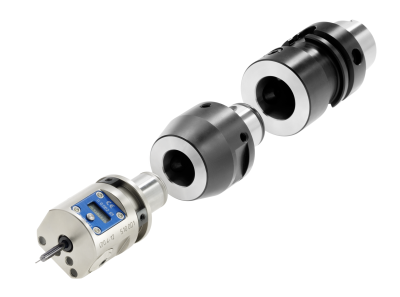
Allied Machine & Engineering announces the continued success of Wohlhaupter’s MVS modular connection system. Part of the Multibore collection, the MVS connection is a flexible system designed primarily for drilling and boring, with application possibilities in tapping, endmilling and light shell milling.
The MVS connection is a modular connection that allows for extended lengths or reduced diameters by using a series of components engineered for flexible adaptation to a manufacturing application. It comes in four sizes to accommodate the diameter range of the boring required: MVS 50-28, 63-36, 80-36 and 100- 56. Operators can easily build and change tooling components and this flexibility lets the MVS system work accurately for almost any project needs.
It offers a mating and clamping draw force of approximately 1,900 psi. This strength is provided by a three-point triangular system. The pressure points are an equal 120 degrees apart, creating high rigidity, high performance capability and a total system accuracy of 3 microns.
The original concept for this connection was developed in 1973. The system holds tolerances of 0.002 microns ID to OD and a consistent 0.002 microns of parallelism between mating surfaces. Only a connection system with the strength of the MVS allows for such tight tolerances and superior quality components and surfaces, according to the company.
Contact Details
Related Glossary Terms
- boring
boring
Enlarging a hole that already has been drilled or cored. Generally, it is an operation of truing the previously drilled hole with a single-point, lathe-type tool. Boring is essentially internal turning, in that usually a single-point cutting tool forms the internal shape. Some tools are available with two cutting edges to balance cutting forces.
- endmilling
endmilling
Operation in which the cutter is mounted on the machine’s spindle rather than on an arbor. Commonly associated with facing operations on a milling machine.
- gang cutting ( milling)
gang cutting ( milling)
Machining with several cutters mounted on a single arbor, generally for simultaneous cutting.
- inner diameter ( ID)
inner diameter ( ID)
Dimension that defines the inside diameter of a cavity or hole. See OD, outer diameter.
- milling
milling
Machining operation in which metal or other material is removed by applying power to a rotating cutter. In vertical milling, the cutting tool is mounted vertically on the spindle. In horizontal milling, the cutting tool is mounted horizontally, either directly on the spindle or on an arbor. Horizontal milling is further broken down into conventional milling, where the cutter rotates opposite the direction of feed, or “up” into the workpiece; and climb milling, where the cutter rotates in the direction of feed, or “down” into the workpiece. Milling operations include plane or surface milling, endmilling, facemilling, angle milling, form milling and profiling.
- outer diameter ( OD)
outer diameter ( OD)
Dimension that defines the exterior diameter of a cylindrical or round part. See ID, inner diameter.
- tapping
tapping
Machining operation in which a tap, with teeth on its periphery, cuts internal threads in a predrilled hole having a smaller diameter than the tap diameter. Threads are formed by a combined rotary and axial-relative motion between tap and workpiece. See tap.

